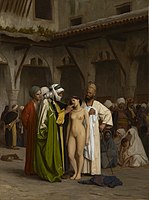Other:CMNF
copied and derived from w:Clothed male, naked female

Clothed male, naked female (CMNF), or clothed male, nude female, is female w:nudity in which one or more women are nude while one or more men are clothed.
In media
Entertainment columnist w:Earl Wilson details several experiences involving one-sided female nudity in his book Show Business Laid Bare.[1] In the chapter "Cheri Caffaro: A Strange Interlewd", Wilson writes about his experience interviewing actress w:Cheri Caffaro while she was nude and he was fully dressed.[2]
Depending on local laws, female nudity of some level is to be found at nude w:body painting events (such as w:Fantasy Fest), w:sex shows, w:strip clubs, and in adult-only public events like w:Folsom Street Fair, w:Nudes-A-Poppin', etc. There have also been TV programs featuring CMNF, such as Denmark's w:Blachman, which featured clothed males judging nude females for their bodies.[3]
As a theme in art
-
w:Édouard Manet - w:Le Déjeuner sur l'herbe (The Picnic), 1863
-
The Slave Market, w:Jean-Léon Gérôme, c. 1884
-
Clothed man next to a naked woman at 2014 w:World Naked Bike Ride in London.
In w:classical antiquity, the portrayal of nude male form in art (including the exposure of genitals) was considered to be more acceptable than that of the naked female form. By the Renaissance, this view had reversed.[4] For example, in w:Titian's treatment of Perseus and Andromeda in the mid-1550s, it is Andromeda who is nude—save for the barest wisp of fabric—while Perseus is clothed in armour.
One-sided female nudity has been a theme in art, particularly in w:Orientalist paintings of the 19th century. A typical scene may be a depiction of w:white slavery in which one or several nude female slaves are displayed before an audience of men at a w:slave market. The archetypal example of this type of scene is w:Jean-Léon Gérôme's w:The Slave Market, in which a nude female slave is examined by a potential buyer. Another example is Gérôme's w:Phryné devant l'Areopage (Phryne before the w:Areopagus, 1861) which was based on the trial of w:Phryne before the Areopagus in ancient Greece. The w:odalisque (harem scene) was also a popular subject for depicting one-sided female nudity, although the clothed figures in the scene were not always male.
Outside of the Orientalist style, a scenario for one-sided female nudity in 19th-century art was the knight-errant, in which the w:damsel in distress was used to explore the erotic subtext of the powerful knight coming to the rescue of a helpless woman. The best known example of this is John Everett Millais' painting w:Knight-errant, in which a nude woman has been tied to a tree and a knight is shown cutting her loose.
Another example is w:Édouard Manet's w:Le déjeuner sur l'herbe ("The Luncheon on the Grass"), in which a nude woman is depicted having lunch with two fully clothed men. The w:Pastoral Concert (c. 1510) attributed to w:Giorgione or his pupil w:Titian[5] has been cited as an inspiration for Manet's painting.
A 1913 painting Adoration by w:William Strang presents a philosophical study of beauty, with the clothed soldier, painter, scholar, and elderly gentleman fascinated by the naked female subject.
See also
- w:Bottom (BDSM)
- w:Candaulism
- w:Erotic humiliation
- w:Exhibitionism
- w:Male dominance (BDSM)
- w:Female submission
- w:Clothed female, naked male
- w:Nyotaimori
- w:Sexual objectification
- w:Voyeurism
References
- ↑ Show Business Laid Bare, by Earl Wilson, Template:ISBN, New York, G. P. Putnam's Sons, 1974. Second Printing
- ↑ The story can be found on pages 45-56 of the hardcover second printing of the book.
- ↑ Template:Cite web
- ↑ Template:Cite book
- ↑ From the Louvre Museum Official Website Template:Webarchive



